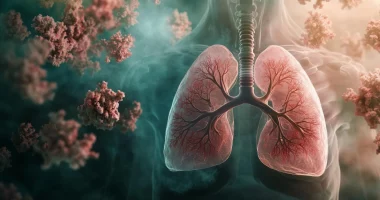Carcinoid syndrome is a condition that can happen to some people who have a type of tumor called a neuroendocrine tumor also known as NET. These tumors consist of special cells called neuroendocrine cells. These cells make hormones when they receive signals from the nervous system. Neuroendocrine cells are found in different parts of the body, like the pancreas and lungs.
In carcinoid syndrome, the NET releases hormones into the bloodstream. Hormones are like messengers that travel through the blood to different parts of the body, telling them what to do. When a NET produces a lot of hormones, it can cause various symptoms, including facial flushing (where the face turns red and feels warm) and diarrhea. These symptoms occur because the excess hormones affect how the body functions.
Symptoms
Carcinoid syndrome can lead to a range of symptoms. One of the most common symptoms is facial flushing, which affects about 85% of people with the condition. This flushing can last from 30 seconds to 30 minutes, though it may sometimes last longer. Diarrhea is another frequent symptom, occurring in around 80% of those affected. Additionally, 60–70% of people with carcinoid syndrome experience cardiac issues, which can include heart problems related to the syndrome.
Other symptoms include wheezing, a fast heartbeat, and a condition called pellagra. Pellagra results from a deficiency of vitamin B3 and can cause symptoms like diarrhea, dementia, and dermatitis. People with carcinoid syndrome may also experience fatigue and cognitive dysfunction, which can affect their daily lives.
Causes
Carcinoid syndrome is caused by neuroendocrine tumors releasing large amounts of hormones into the body. The American Cancer Society reports that about 10 percent of NETs lead to this syndrome. In the past, these tumors were often called carcinoid tumors.
Normally, the liver neutralizes excess hormones that the body doesn’t need. However, carcinoid syndrome can happen if the hormones enter the bloodstream directly or if the liver’s function is compromised. This leads to various symptoms associated with the syndrome.
NETs that develop in the midgut, which includes the small intestine, appendix, ascending colon, and cecum, are the most common cause of carcinoid syndrome. Additionally, particular NETs, like those in the lungs and ovaries, can release hormones straight into the bloodstream, potentially causing carcinoid syndrome even without extending to the liver.
Diagnosis
To diagnose carcinoid syndrome, healthcare providers typically use a combination of laboratory and imaging tests. One of the first tests they may utilize measures the amount of 5-hydroxyindoleacetic acid in an individual’s urine over a day. 5-HIAA is a byproduct of serotonin breakdown, a hormone that neuroendocrine tumors can secrete. High levels of 5-HIAA in the urine may specify carcinoid syndrome.
Before the 5-HIAA test, healthcare professionals provide a list of medications and foods to avoid for at least 24 hours before the test, as they can affect the results. Additionally, healthcare providers may measure the level of chromogranin A (CgA) in the blood, another molecule produced by NETs.
To further investigate and confirm the diagnosis, healthcare providers may use imaging tests such as MRIs, CT scans, octreotide scans, and bronchoscopy with biopsy. These tests help locate the tumor and assess its spread. Doctors can provide detailed explanations about each test and address any questions patients may have.
Treatments
Treatment for carcinoid syndrome varies for each person and often includes a combination of medical interventions and symptom management strategies.
Medical Treatments
Doctors may use several medical treatments to manage carcinoid syndrome, including:
- Surgery: Removing all or most of the neuroendocrine tumor (NET) can be effective.
- Medications: Somatostatin analogs can inhibit the release of certain hormones.
- Antidiarrheal medications: These help control diarrhea, a common symptom.
- Chemotherapy: Used to target and kill cancer cells.
- Radiotherapy: Uses radiation to shrink tumors.
- Targeted therapy: Focuses on specific molecules involved in cancer growth.
Managing Symptoms
Certain factors can trigger symptoms in people with carcinoid syndrome, including alcohol, stress, and heavy exercise. Avoiding these triggers can help decrease symptoms. Managing stress is crucial and can be achieved by:
- Ensuring adequate quality sleep.
- Getting support from family and friends.
- Ceasing smoking.
- Practicing meditation.
It’s also essential to consult with a healthcare provider for personalized advice on exercise and additional ways to manage symptoms. The healthcare providers can provide specific recommendations tailored to each individual’s needs.
Complications
Carcinoid syndrome can lead to several serious complications. One major issue is damage to the heart valves, which can result in conditions like valvular heart disease or heart failure. This occurs because the excess hormones released by neuroendocrine tumors can affect the heart’s function over time.
Another severe complication is a condition known as carcinoid crisis. This life-threatening situation happens when NETs release a large number of hormones all at once, leading to symptoms like hypotension, breathing difficulties, and facial flushing. It can be triggered by factors like anesthetics, sedatives, surgery, the death of the NET, and the release of catecholamines (hormones that act as neurotransmitters).
It’s crucial to seek medical advice as early as possible to begin appropriate treatment and minimize the chance of these complications. Early intervention can help manage symptoms and improve outcomes for those with carcinoid syndrome.
When to Consult a Healthcare Provider
A person should contact a healthcare provider if they notice any symptoms or signs of carcinoid syndrome, such as facial flushing, diarrhea, or difficulty breathing. It’s important to seek medical attention because carcinoid syndrome can cause damage to the heart over time.
Getting an accurate diagnosis and starting treatment early can help prevent or decrease the risk of heart problems and other complications. Early medical intervention is key to managing the condition effectively and improving overall health outcomes.
Summary
Carcinoid syndrome is caused by neuroendocrine tumors releasing hormones, leading to symptoms like facial flushing and diarrhea. It can cause complications such as heart valve damage and carcinoid crisis, which are life-threatening. Diagnosis involves tests like measuring 5-HIAA levels and imaging scans.
Treatment includes surgery, medications, and symptom management strategies like stress reduction. It’s crucial to seek early medical advice for diagnosis and treatment to prevent complications. Early intervention helps manage the condition and improves health outcomes.









